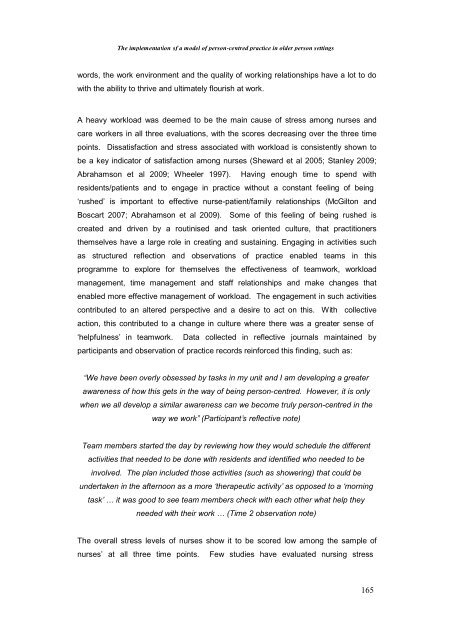The Implementation of a Model of Person-Centred Practice In Older ...
The Implementation of a Model of Person-Centred Practice In Older ...
The Implementation of a Model of Person-Centred Practice In Older ...
Create successful ePaper yourself
Turn your PDF publications into a flip-book with our unique Google optimized e-Paper software.
<strong>The</strong> implementation <strong>of</strong> a model <strong>of</strong> person-centred practice in older person settings<br />
words, the work environment and the quality <strong>of</strong> working relationships have a lot to do<br />
with the ability to thrive and ultimately flourish at work.<br />
A heavy workload was deemed to be the main cause <strong>of</strong> stress among nurses and<br />
care workers in all three evaluations, with the scores decreasing over the three time<br />
points. Dissatisfaction and stress associated with workload is consistently shown to<br />
be a key indicator <strong>of</strong> satisfaction among nurses (Sheward et al 2005; Stanley 2009;<br />
Abrahamson et al 2009; Wheeler 1997). Having enough time to spend with<br />
residents/patients and to engage in practice without a constant feeling <strong>of</strong> being<br />
‘rushed’ is important to effective nurse-patient/family relationships (McGilton and<br />
Boscart 2007; Abrahamson et al 2009). Some <strong>of</strong> this feeling <strong>of</strong> being rushed is<br />
created and driven by a routinised and task oriented culture, that practitioners<br />
themselves have a large role in creating and sustaining. Engaging in activities such<br />
as structured reflection and observations <strong>of</strong> practice enabled teams in this<br />
programme to explore for themselves the effectiveness <strong>of</strong> teamwork, workload<br />
management, time management and staff relationships and make changes that<br />
enabled more effective management <strong>of</strong> workload. <strong>The</strong> engagement in such activities<br />
contributed to an altered perspective and a desire to act on this. With collective<br />
action, this contributed to a change in culture where there was a greater sense <strong>of</strong><br />
‘helpfulness’ in teamwork. Data collected in reflective journals maintained by<br />
participants and observation <strong>of</strong> practice records reinforced this finding, such as:<br />
“We have been overly obsessed by tasks in my unit and I am developing a greater<br />
awareness <strong>of</strong> how this gets in the way <strong>of</strong> being person-centred. However, it is only<br />
when we all develop a similar awareness can we become truly person-centred in the<br />
way we work” (Participant’s reflective note)<br />
Team members started the day by reviewing how they would schedule the different<br />
activities that needed to be done with residents and identified who needed to be<br />
involved. <strong>The</strong> plan included those activities (such as showering) that could be<br />
undertaken in the afternoon as a more ‘therapeutic activity’ as opposed to a ‘morning<br />
task’ … it was good to see team members check with each other what help they<br />
needed with their work … (Time 2 observation note)<br />
<strong>The</strong> overall stress levels <strong>of</strong> nurses show it to be scored low among the sample <strong>of</strong><br />
nurses’ at all three time points.<br />
Few studies have evaluated nursing stress<br />
165
















